Land Cover Dynamics and Environmental Implications in Türkiye’s Riparian Zones: A Comprehensive Seven-Year Study
Abstract
:1. Introduction
2. Materials and Methods
2.1. Study Area
2.2. Datasets
2.3. Stream Banks Delineation
2.4. RBZs Delineation
2.5. Land Cover and Change Analysis
2.6. Data Analyses
3. Results
4. Discussion
5. Conclusions
Author Contributions
Funding
Data Availability Statement
Conflicts of Interest
References
- Mukheibir, P. Water access, water scarcity, and climate change. Environ. Manag. 2010, 45, 1027–1039. [Google Scholar] [CrossRef]
- G20 High-Level Principles for Digital Financial Inclusion Sustainable Development Knowledge Platform. Available online: https://sustainabledevelopment.un.org/index.php?page=view&type=400&nr=2667&menu=1515 (accessed on 13 June 2023).
- Maraseni, T.N.; Mitchell, C. An assessment of carbon sequestration potential of riparian zone of Condamine Catchment, Queensland, Australia. Land Use Policy 2016, 54, 139–146. [Google Scholar] [CrossRef]
- Yilmaz, M.; Çiçek, E. Yüzeysel su kaynakları çevresinde ormancılık etkinlikleri. J. Fac. For. Istanb. Univ. 2002, 52, 95–110. [Google Scholar]
- Naiman, R.J.; Decamps, H. The ecology of interfaces: Riparian zones. Annu. Rev. Ecol. Syst. 1997, 28, 621–658. [Google Scholar] [CrossRef]
- Sweeney, B.W.; Bott, T.L.; Jackson, J.K.; Kaplan, L.A.; Newbold, J.D.; Standley, L.J.; Horwitz, R.J. Riparian deforestation, stream narrowing, and loss of stream ecosystem services. Proc. Natl. Acad. Sci. USA 2004, 101, 14132–14137. [Google Scholar] [CrossRef]
- Monteiro, J.A.; Kamali, B.; Srinivasan, R.; Abbaspour, K.; Gücker, B. Modelling the effect of riparian vegetation restoration on sediment transport in a human-impacted Brazilian catchment. Ecohydrology 2016, 9, 1289–1303. [Google Scholar] [CrossRef]
- Tabacchi, E.; Lambs, L.; Guilloy, H.; Planty-Tabacchi, A.M.; Muller, E.; Decamps, H. Impacts of riparian vegetation on hydrological processes. Hydrol. Process. 2000, 14, 2959–2976. [Google Scholar] [CrossRef]
- Pettit, N.E.; Naiman, R.J. Fire in the riparian zone: Characteristics and ecological consequences. Ecosystems 2007, 10, 673–687. [Google Scholar] [CrossRef]
- González, E.; Felipe-Lucia, M.R.; Bourgeois, B.; Boz, B.; Nilsson, C.; Palmer, G.; Sher, A.A. Integrative conservation of riparian zones. Biol. Conserv. 2017, 211, 20–29. [Google Scholar] [CrossRef]
- Majumdar, A.; Avishek, K. Riparian zone assessment and management: An integrated review using geospatial technology. Water Air Soil Pollut. 2023, 234, 319. [Google Scholar] [CrossRef]
- Buffin-Bélanger, T.; Biron, P.M.; Larocque, M.; Demers, S.; Olsen, T.; Choné, G.; Eyquem, J. Freedom space for rivers: An economically viable river management concept in a changing climate. Geomorphology 2015, 251, 137–148. [Google Scholar] [CrossRef]
- Kujanová, K.; Matoušková, M.; Hošek, Z. The relationship between river types and land cover in riparian zones. Limnologica 2018, 71, 29–43. [Google Scholar] [CrossRef]
- Patten, D.T. Riparian ecosytems of semi-arid North America: Diversity and human impacts. Wetlands 1998, 18, 498–512. [Google Scholar] [CrossRef]
- Burbrink, F.T.; Phillips, C.A.; Heske, E.J. A riparian zone in southern Illinois as a potential dispersal corridor for reptiles and amphibians. Biol. Conserv. 1998, 86, 107–115. [Google Scholar] [CrossRef]
- Risser, P.G. The ecological importance of land-water ecotones. In The Ecology and Management of Aquatic-Terrestrial Ecotones; Robert, J.N., Henri, D., Eds.; The Parthenon Publishing Group: London, UK, 1990; Volume 4, pp. 7–21. [Google Scholar]
- Fonseca, A.; Ugille, J.P.; Michez, A.; Rodríguez-González, P.M.; Duarte, G.; Ferreira, M.T.; Fernandes, M.R. Assessing the connectivity of Riparian Forests across a gradient of human disturbance: The potential of Copernicus “Riparian Zones” in two hydroregions. Forests 2021, 12, 674. [Google Scholar] [CrossRef]
- Zhang, A.Y.; Wang, Q.; Wu, C.; Ma, W.; Zhou, M.; Cao, K. Spatial and temporal analysis of water quality trends in the Min River Basin. In Proceedings of the 2012 International Symposium on Geomatics for Integrated Water Resource Management, Lanzhou, China, 19–21 October 2012; IEEE: Piscataway, NJ, USA, 2012. [Google Scholar]
- de Mello, K.; Valente, R.A.; Randhir, T.O.; dos Santos, A.C.A.; Vettorazzi, C.A. Effects of land use and land cover on water quality of low-order streams in Southeastern Brazil: Watershed versus riparian zone. Catena 2018, 167, 130–138. [Google Scholar] [CrossRef]
- Claessens, L.; Hopkinson, C.; Rastetter, E.; Vallino, J. Effect of historical changes in land use and climate on the water budget of an urbanizing watershed. Water Resour. Res. 2006, 42, 1–13. [Google Scholar] [CrossRef]
- Li, S.; Liu, W.; Gu, S.; Cheng, X.; Xu, Z.; Zhang, Q. Spatio-temporal dynamics of nutrients in the upper Han River basin, China. J. Hazard. Mater. 2009, 162, 1340–1346. [Google Scholar] [CrossRef]
- Dufour, S.; Rodríguez-González, P.M.; Laslier, M. Tracing the scientific trajectory of riparian vegetation studies: Main topics, approaches and needs in a globally changing world. Sci. Total Environ. 2019, 653, 1168–1185. [Google Scholar] [CrossRef]
- Mevzuat. Available online: https://www.mevzuat.gov.tr/File/GeneratePdf?mevzuatNo=19546&mevzuatTur=KurumVeKurulusYonetmeligi&mevzuatTertip=5 (accessed on 12 May 2024).
- OGM. Available online: https://www.ogm.gov.tr/tr/e-kutuphane-sitesi/mevzuat-sitesi/Tebligler/Silvikültür%20Uygulamalarının%20Teknik%20Esasları.pdf (accessed on 12 May 2024).
- Gültekin, Y.S. An Overview of Studies on “Riparian Ecosystems” in Turkey (2010–2021). J. Int. Sci. Publ. Ecol. Saf. 2021, 15, 73–81. [Google Scholar]
- Abdullah, E. Mapping and analysis of riparian forests: Case study of baskonus research and application forest in Kahramanmaras, Turkey. Technology 2010, 13, 251–260. [Google Scholar]
- Akay, A.E.; Sivrikaya, F.; Gulci, S. Analyzing riparian forest cover changes along the Firniz River in the Mediterranean City of Kahramanmaras in Turkey. Environ. Monit. Assess. 2014, 186, 2741–2747. [Google Scholar] [CrossRef]
- Zogaris, S.; Markogianni, V.; Özeren, S.C.; Dimitriou, E. Assessment of Riparian zone and river Island conditions in a Trans-boundary greenbelt: The Evros/Meriç river (Greece-Turkey). Fresenius Environ. Bull. 2015, 24, 269–277. [Google Scholar]
- Karakuş, C.B. Assessment of relationship between land use/cover and surface water quality trends within the riparian zone: A case study from Sivas, Turkey. Desalination Water Treat. 2020, 182, 414–433. [Google Scholar] [CrossRef]
- Özdeniz, E.; Kurt, L.; Bergmeier, E. Syntaxonomical analysis of the riparian vegetation of the Porsuk River (Eskişehir-Kütahya/Turkey). Turk. J. Bot. 2017, 41, 609–619. [Google Scholar] [CrossRef]
- Keten, A.; Eroglu, E.; Kaya, S.; Anderson, J.T. Bird diversity along a riparian corridor in a moderate urban landscape. Ecol. Indic. 2020, 118, 106751. [Google Scholar] [CrossRef]
- 2020 Türkiye Orman Varlığı. Available online: https://www.ogm.gov.tr/tr/ormanlarimiz-sitesi/TurkiyeOrmanVarligi/Yayinlar/2020%20T%C3%BCrkiye%20Orman%20Varl%C4%B1%C4%9F%C4%B1.pdf (accessed on 9 May 2024).
- Aksoy, N.; Tuğ, N.G.; Eminağaoğlu, Ö. Türkiye’nin Vejetasyon Yapısı. In Türkiye’nin Doğal-Egzotik Ağaç ve Çalıları 1; T.C. Orman ve Su İşleri Bakanlığı Yayınları: Ankara, Türkiye, 2014. [Google Scholar]
- Akyol, İ. Türkiye’de akarsu sistemleri ve rejimleri. Türk Coğrafya Derg. 1947, 9–10, 1–35. [Google Scholar]
- Akbulut, N.E.; Bayarı, S.; Akbulut, A.; Özyurt, N.N.; Sahin, Y. Rivers of Turkey. In Rivers of Europe; Elsevier: Amsterdam, The Netherlands, 2022; pp. 853–882. [Google Scholar] [CrossRef]
- Tarım ve Orman Bakanlığı Doğa Koruma ve Milli Parklar Genel Müdürlüğü. Available online: https://www.tarimorman.gov.tr/DKMP/Menu/31/Sulak-Alanlar (accessed on 25 June 2024).
- Erinç, S. Klimatoloji ve Metodları; No: 3278; İstanbul Üniversitesi Yayınları: İstanbul, Türkiye, 1984; Volume 2. [Google Scholar]
- Ölgen, M.K. Türkiye’de yillik ve mevsimsel yağiş değişkenliğinin alansal dağilimi. Ege Coğrafya Derg. 2010, 19, 85–95. [Google Scholar]
- Akpınar, E. Nehir tipi santrallerin Türkiye’nin hidroelektrik üretimindeki yeri. Erzincan Üniversitesi Eğitim Fakültesi Derg. 2005, 7, 1–25. [Google Scholar]
- DSI. Available online: https://dsi.gov.tr/Sayfa/Detay/754 (accessed on 9 May 2024).
- European Environment Agency. Available online: https://www.eea.europa.eu/publications/eea_report_2005_4/download (accessed on 9 May 2024).
- Wickel, B.A.; Lehner, B.; Sindorf, N. HydroSHEDS: A global comprehensive hydrographic dataset. In AGU Fall Meeting Abstracts; American Geophysical Union: San Francisco, CA, USA, 2007; p. H11H-05. [Google Scholar]
- Linke, S.; Lehner, B.; Ouellet Dallaire, C.; Ariwi, J.; Grill, G.; Anand, M.; Beames, P.; Burchard-Levine, V.; Maxwell, S.; Moidu, H.; et al. Global hydro-environmental sub-basin and river reach characteristics at high spatial resolution. Sci. Data 2019, 6, 283. [Google Scholar] [CrossRef] [PubMed]
- Lehner, B.; Messager, M.L.; Korver, M.C.; Linke, S. Global hydro-environmental lake characteristics at high spatial resolution. Sci. Data 2022, 9, 351. [Google Scholar] [CrossRef]
- USGS. Available online: https://www.usgs.gov/centers/eros/science/usgs-eros-archive-digital-elevation-shuttle-radar-topography-mission-srtm-1?qt-science_center_objects=0#qt-science_center_objects (accessed on 2 April 2024).
- ESRI. Available online: https://livingatlas.arcgis.com/landcover/ (accessed on 2 April 2024).
- Karra, K.; Kontgis, C.; Statman-Weil, Z.; Mazzariello, J.C.; Mathis, M.; Brumby, S.P. Global land use/land cover with Sentinel 2 and deep learning. In Proceedings of the 2021 IEEE International Geoscience and Remote sensing Symposium IGARSS, Brussels, Belgium, 11–16 July 2021; IEEE: Piscataway, NJ, USA, 2021. [Google Scholar] [CrossRef]
- Hughes, A.O. Riparian management and stream bank erosion in New Zealand. N. Z. J. Mar. Freshw. Res. 2016, 50, 277–290. [Google Scholar] [CrossRef]
- Fryirs, K.; Spink, A.; Brierley, G. Post-European settlement response gradients of river sensitivity and recovery across the upper Hunter catchment, Australia. Earth Surf. Process. Landf. 2009, 34, 897–918. [Google Scholar] [CrossRef]
- Wenger, S.J. A Review of the Scientific Literature on Riparian Buffer Width, Extent and Vegetation; University of Georgia, Public Service & Outreach, Institute of Ecology: Athens, GA, USA, 1999; 59p. [Google Scholar]
- Lee, P.; Smyth, C.; Boutin, S. Quantitative review of riparian buffer width guidelines from Canada and the United States. J. Environ. Manag. 2004, 70, 165–180. [Google Scholar] [CrossRef]
- McDermott, C.; Cashore, B.; Kanowski, P. Global Environmental Forest Policies, 1st ed.; Earthscan: London, UK, 2010; ISBN 978-1-84977-492-5. [Google Scholar]
- King, S.E.; Osmond, D.L.; Smith, J.; Burchell, M.R.; Dukes, M.; Evans, R.O.; Kunickis, S. Effects of riparian buffer vegetation and width: A 12-year longitudinal study. J. Environ. Qual. 2016, 45, 1243–1251. [Google Scholar] [CrossRef]
- Akturk, E.; Post, C.; Mikhailova, E.A. Modeling and monitoring riparian buffer zones using LiDAR data in South Carolina. Environ. Monit. Assess. 2020, 192, 350. [Google Scholar] [CrossRef]
- Strahler, A.N. Quantitative analysis of watershed geomorphology. Eos Trans. Am. Geophys. Union 1957, 38, 913–920. [Google Scholar] [CrossRef]
- Venter, Z.S.; Barton, D.N.; Chakraborty, T.; Simensen, T. Global 10 m Land Use Land Cover Datasets: A Comparison of Dynamic World, World Cover and Esri Land Cover. Remote Sens. 2022, 14, 4101. [Google Scholar] [CrossRef]
- McLeod, A.I. Kendall: Kendall Rank Correlation and Mann-Kendall Trend Test. R Package Version 22. Available online: https://cran.r-project.org/web/packages/Kendall/index.html (accessed on 2 April 2024).
- Hayakawa, A.; Shimizu, M.; Woli, K.P.; Kuramochi, K.; Hatano, R. Evaluating stream water quality through land use analysis in two grassland catchments: Impact of wetlands on stream nitrogen concentration. J. Environ. Qual. 2006, 35, 617–627. [Google Scholar] [CrossRef]
- Fiquepron, J.; Garcia, S.; Stenger, A. Land use impact on water quality: Valuing forest services in terms of the water supply sector. J. Environ. Manag. 2013, 126, 113–121. [Google Scholar] [CrossRef]
- Davies, B.; Biggs, J.; Williams, P.; Thompson, S. Making agricultural landscapes more sustainable for freshwater biodiversity: A case study from southern England. Aquat. Conserv. Mar. Freshw. Ecosyst. 2009, 19, 439–447. [Google Scholar] [CrossRef]
- Laegreid, M.; Bockman, O.C.; Kaarstad, O. Agriculture Fertilizers and the Environment; CABI Publishing in Association with Norsk Hydro ASA: New York, NY, USA, 1999; pp. 5–13. [Google Scholar]
- Sanchez, A.P. Properties and Management of Soils in the Tropics; Cambridge University Press: New York, NY, USA, 2019. [Google Scholar]
- Johnson, C.; Albrecht, G. Nitrogen basics–the nitrogen cycle. Agron. Fact Sheet Ser. Fact Sheet 2005, 2, 1–2. [Google Scholar]
- García-Garizábal, I.; Causapé, J.; Abrahão, R. Nitrate contamination and its relationship with flood irrigation management. J. Hydrol. 2012, 442, 15–22. [Google Scholar] [CrossRef]
- da Silva, R.L.; Leite, M.F.A.; Muniz, F.H.; de Souza, L.A.G.; de Moraes, F.H.R.; Gehring, C. Degradation impacts on riparian forests of the lower Mearim river, eastern periphery of Amazonia. For. Ecol. Manag. 2017, 402, 92–101. [Google Scholar] [CrossRef]
- Bourgeois, B.; Vanasse, A.; Rivest, D.; Poulin, M. Establishment success of trees planted in riparian buffer zones along an agricultural intensification gradient. Agric. Ecosyst. Environ. 2016, 222, 60–66. [Google Scholar] [CrossRef]
- Göçoğlu, V.; Göksu, S. How do industrialization and agricultural land use affect urban population in Turkey? Policy implications in the context of SDGs. J. Policy Model. 2024, 46, 198–211. [Google Scholar] [CrossRef]
- World Health Organization. Global action plan on physical activity 2018–2030: More active people for a healthier world. J. Policy Model. 2018, 113, 113. [Google Scholar]

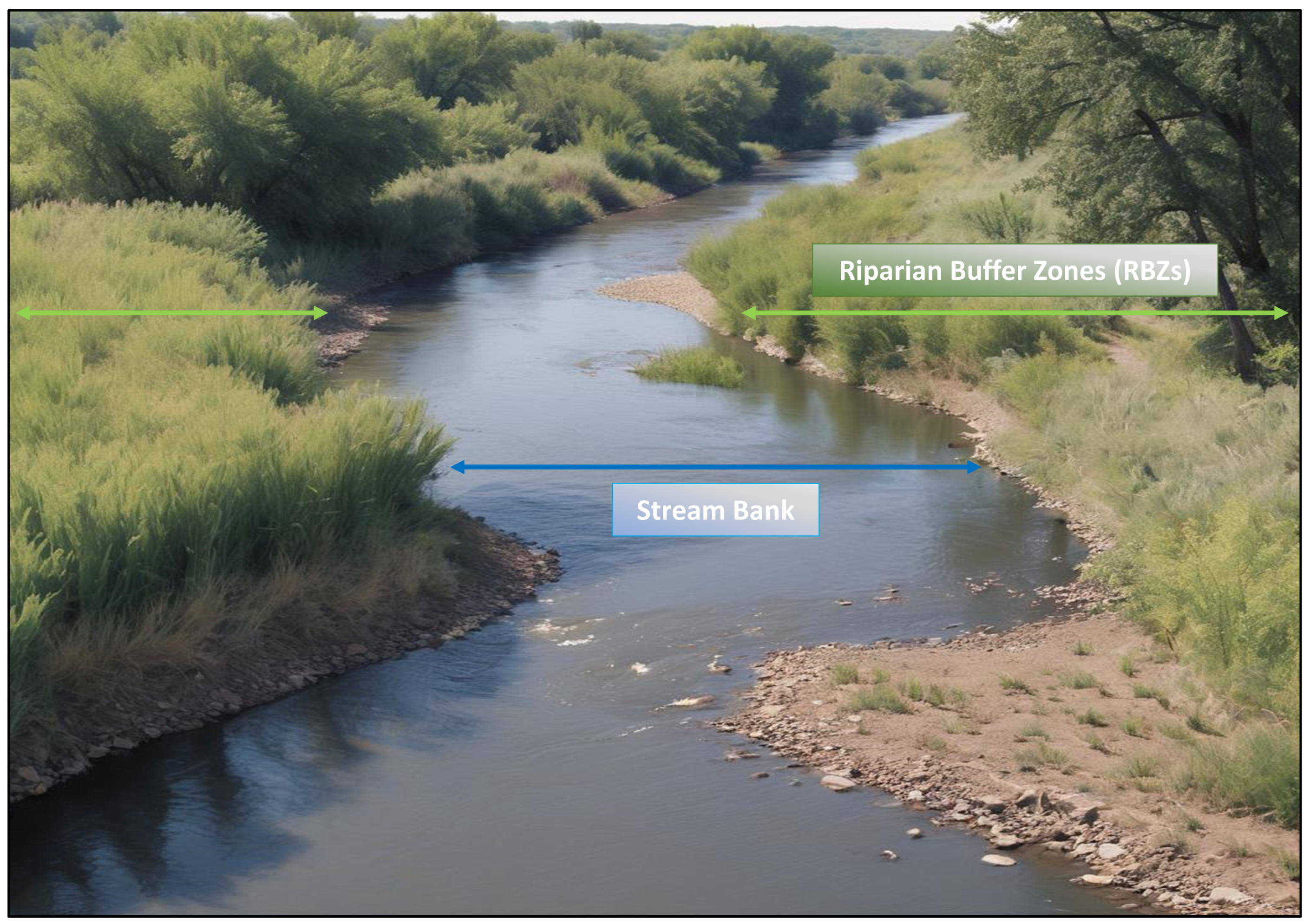
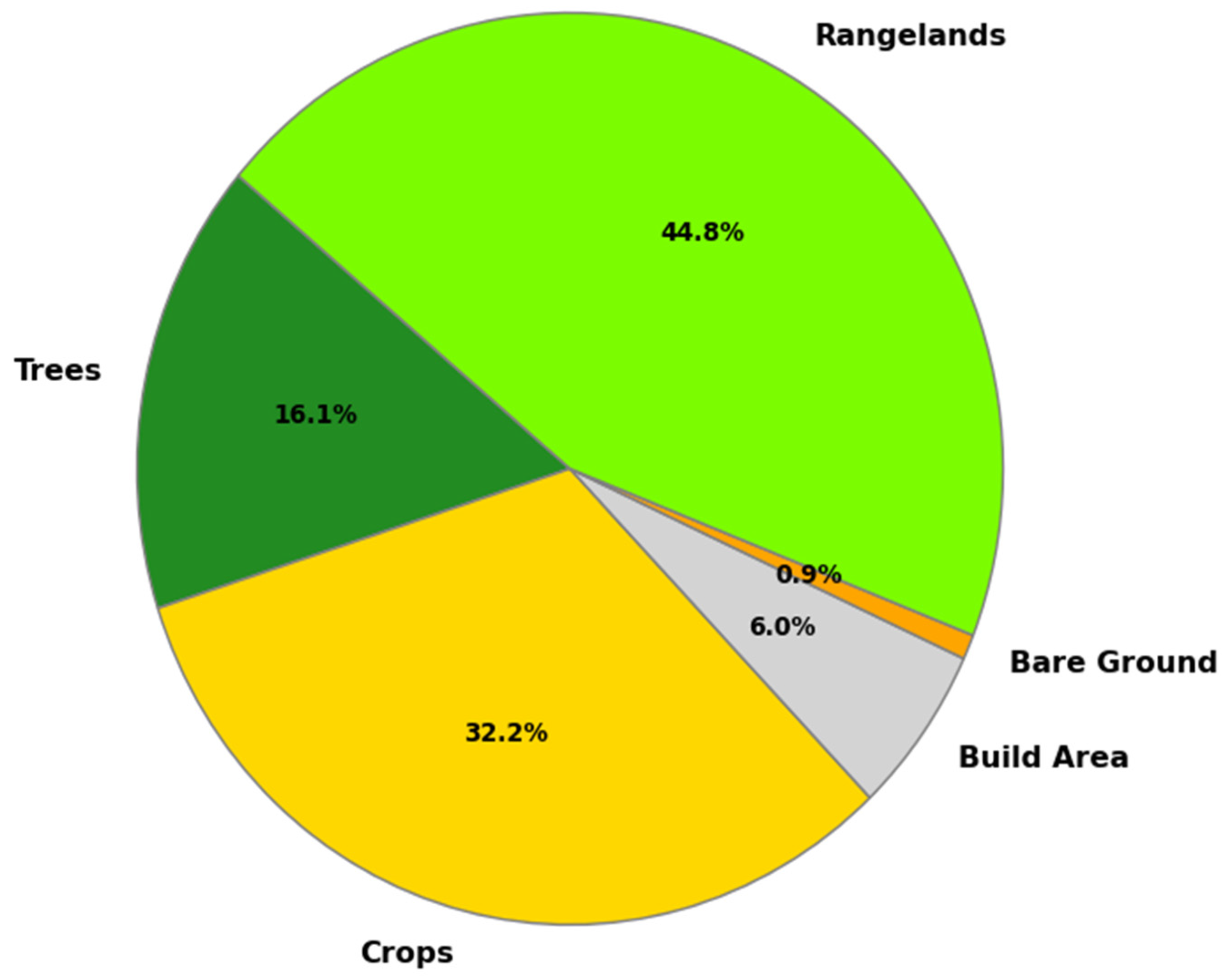
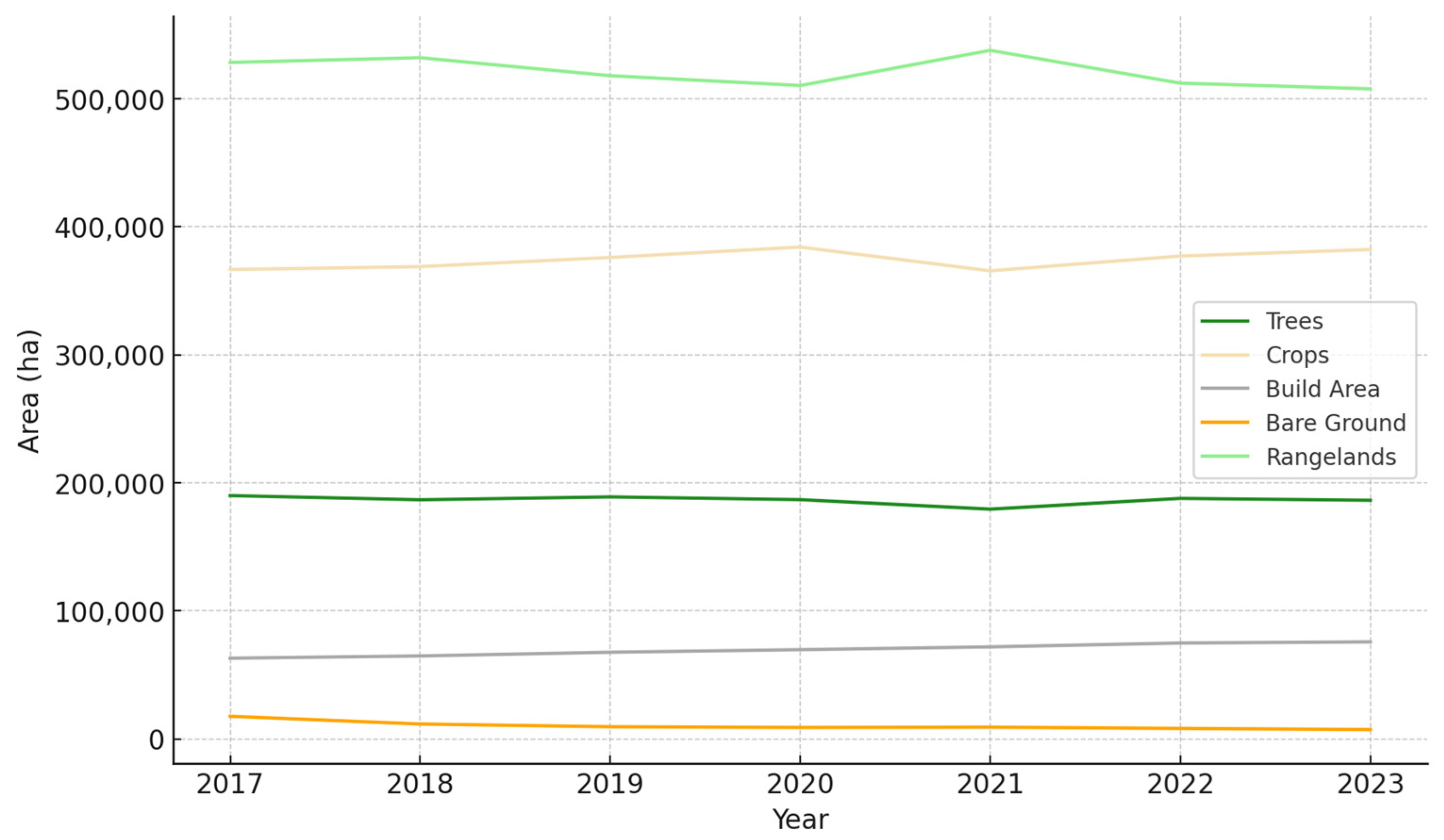
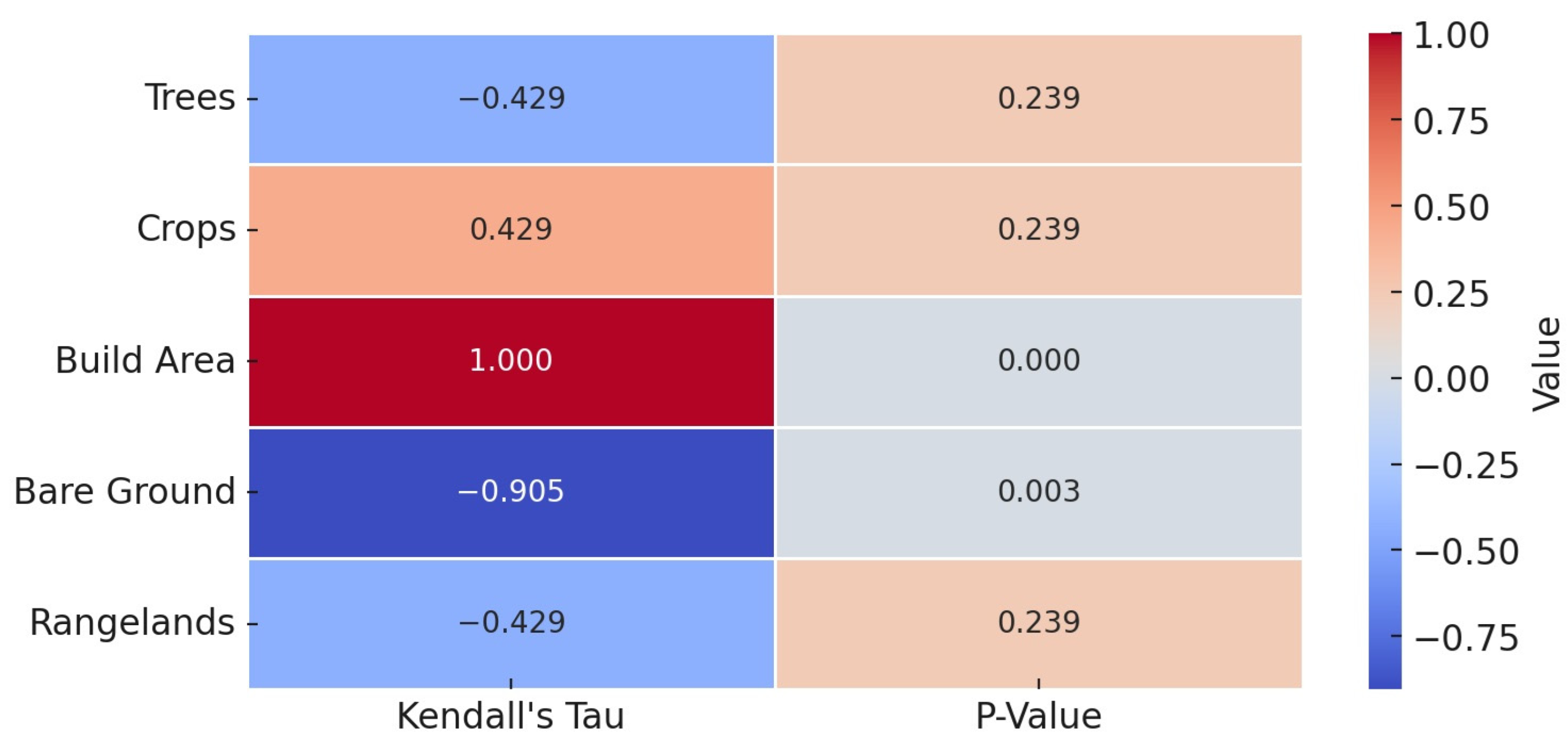
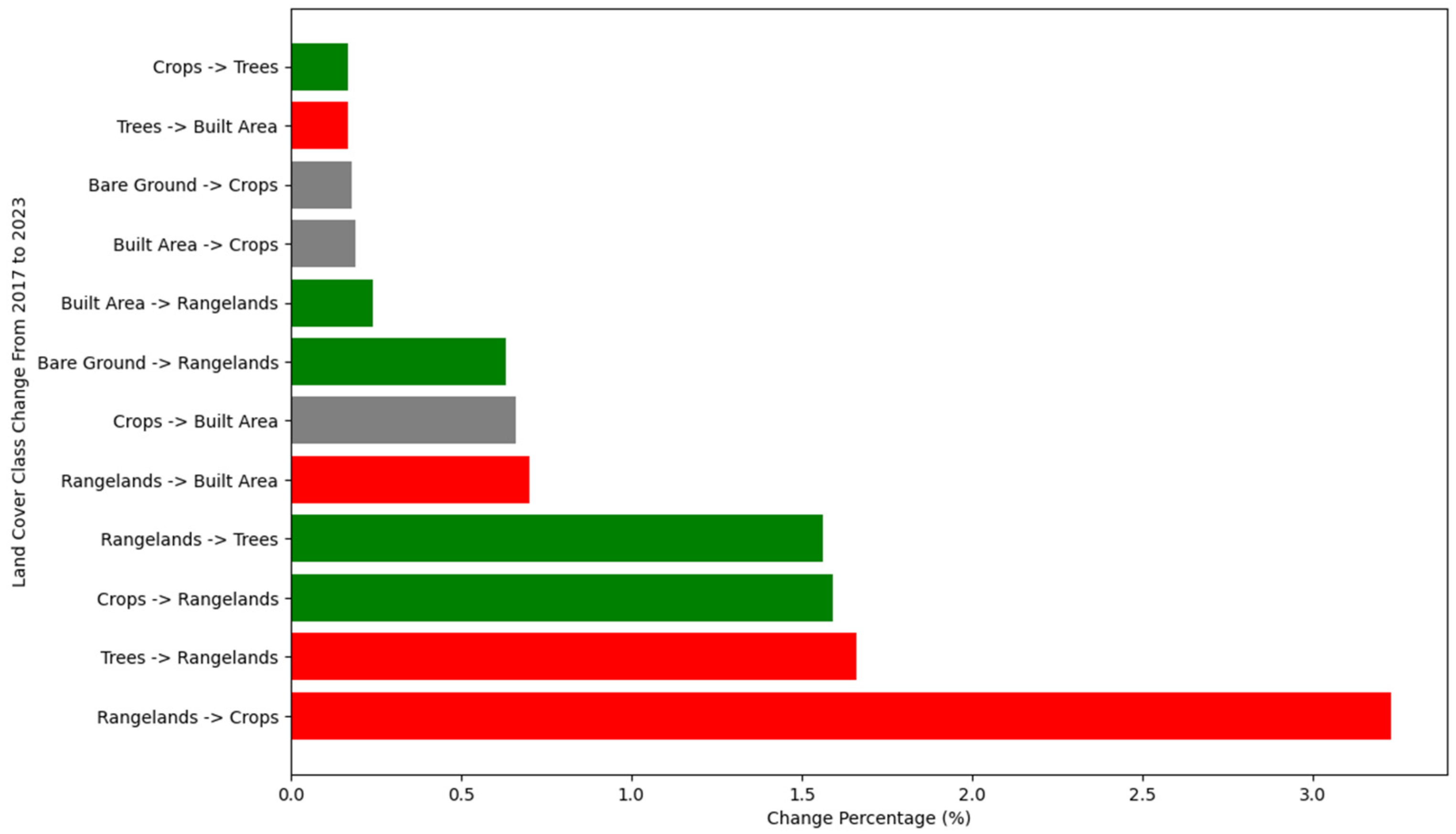
| Stream Type | |||
|---|---|---|---|
| Small (Tributaries) | Large (Headwater Streams) | ||
| Slope Percentage (%) | <20% | 30 m | 50 m |
| ≥20% | 50 m | 100 m | |
| Year | Land Cover within RBZs (ha) | |||||||
|---|---|---|---|---|---|---|---|---|
| Trees | Flood. Veg. | Crops | Built Area | Bare Ground | Snow-Ice | Clouds | Rangelands | |
| 2017 | 189,984 | 913 | 366,558 | 62,961 | 17,621 | 40 | 5 | 528,277 |
| 2018 | 186,941 | 892 | 369,364 | 64,823 | 11,544 | 58 | 8 | 532,729 |
| 2019 | 189,821 | 974 | 377,680 | 67,958 | 9409 | 63 | 9 | 520,445 |
| 2020 | 187,705 | 894 | 385,981 | 69,991 | 8827 | 55 | 5 | 512,901 |
| 2021 | 179,710 | 773 | 366,147 | 71,965 | 9068 | 60 | 10 | 538,626 |
| 2022 | 188,861 | 799 | 378,859 | 75,195 | 8074 | 56 | 13 | 514,502 |
| 2023 | 187,322 | 782 | 384,267 | 76,139 | 7194 | 51 | 13 | 510,591 |
| Average | 187,192 | 861 | 375,550 | 69,861 | 10,247 | 55 | 9 | 522,581 |
Disclaimer/Publisher’s Note: The statements, opinions and data contained in all publications are solely those of the individual author(s) and contributor(s) and not of MDPI and/or the editor(s). MDPI and/or the editor(s) disclaim responsibility for any injury to people or property resulting from any ideas, methods, instructions or products referred to in the content. |
© 2024 by the authors. Licensee MDPI, Basel, Switzerland. This article is an open access article distributed under the terms and conditions of the Creative Commons Attribution (CC BY) license (https://creativecommons.org/licenses/by/4.0/).
Share and Cite
Akturk, E.; Guney, K.; Aydin, M.; Yildiz, F.; Kaya, O. Land Cover Dynamics and Environmental Implications in Türkiye’s Riparian Zones: A Comprehensive Seven-Year Study. Forests 2024, 15, 1177. https://doi.org/10.3390/f15071177
Akturk E, Guney K, Aydin M, Yildiz F, Kaya O. Land Cover Dynamics and Environmental Implications in Türkiye’s Riparian Zones: A Comprehensive Seven-Year Study. Forests. 2024; 15(7):1177. https://doi.org/10.3390/f15071177
Chicago/Turabian StyleAkturk, Emre, Kerim Guney, Mirac Aydin, Faruk Yildiz, and Ozkan Kaya. 2024. "Land Cover Dynamics and Environmental Implications in Türkiye’s Riparian Zones: A Comprehensive Seven-Year Study" Forests 15, no. 7: 1177. https://doi.org/10.3390/f15071177








